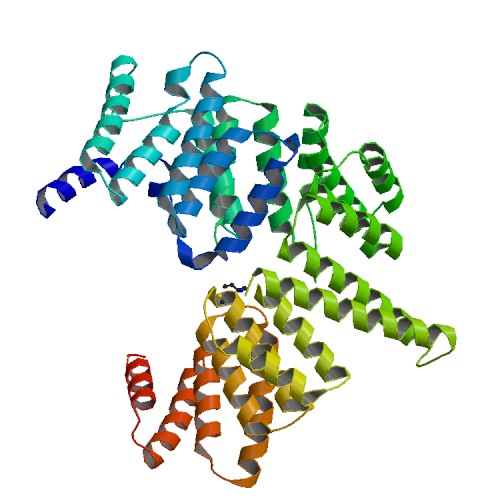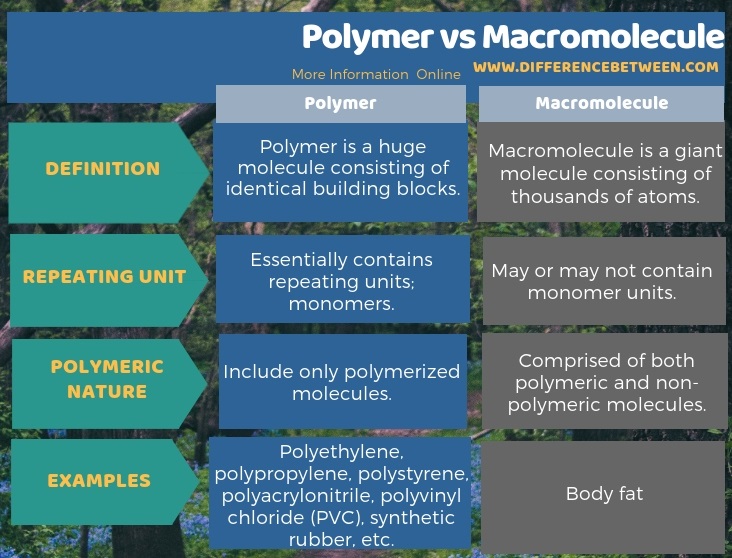Difference Between Polymer and Macromolecule
The key difference between polymer and macromolecule is that the polymer is a macromolecule with a repeating unit called monomer throughout the molecular structure whereas, not every macromolecule has a monomer in their structure.
The difference between polymer and macromolecule stems from the fact that polymer is a subdivision of macromolecule. Macromolecules are extremely large molecules with high molecular weight. Also, we can subdivide a macromolecule into two main categories according to its structure. Namely, they are polymerized molecules and non-polymerized molecules. On the other hand, the polymer forms from the polymerization of small molecules, which are the monomers. But, all macromolecules do not comprise a monomer unit repeating throughout its structure.
CONTENTS
1. Overview and Key Difference
2. What is a Polymer
3. What is a Macromolecule
4. Side by Side Comparison – Polymer vs Macromolecule in Tabular Form
5. Summary
What is a Polymer?
The word polymer means many parts (“poly” = many and “mer” = parts); this term originated from two Greek words “polus” (= many) and “meros” (= parts). Polymer is a huge molecule containing identical building blocks. Each polymer has a repeating unit called the monomer. Furthermore, there are naturally occurring polymers as well as artificially synthesized polymers. For example, shellac, wool, silk, natural rubber and amber are some of the natural polymers. Cellulose is another natural polymer which we can find in wood and paper. Also, bio-polymers occur in biological systems; proteins (polyamides), nucleic acids (polynucleotides) and carbohydrates are few examples of bio-polymers.
Besides, in the modern world, there are a large number of artificial synthesized polymers, which have numerous uses in our day to day life. These materials are very convenient to use. For example, polyethylene, polypropylene, polystyrene, polyacrylonitrile, polyvinyl chloride (PVC), synthetic rubber and phenol formaldehyde resin (Bakelite) are some of the mostly abundant artificial polymers. However, many of the artificial polymers are not bio-degradable.
http://https://vimeo.com/160880037
Classification of Polymers
Properties of polymers vary depending on the structure and the bonding type of the molecule. Also, addition of polymers usually occurs across the carbon-carbon double bond. Furthermore, it also includes ring opening systems. Vinyl polymers mostly fall into this category.
| Polymer | Formula | Monomer |
| Polyethylene low density (LDPE) | –(CH2-CH2)n– | ethylene CH2=CH2 |
| Polyethylene high density (HDPE) | –(CH2-CH2)n– | ethylene CH2=CH2 |
| Polypropylene (PP) different grades | –[CH2-CH(CH3)]n– | propylene CH2=CHCH3 |
| Poly(vinyl chloride) (PVC) | –(CH2-CHCl)n– | vinyl chloride CH2=CHCl |
| Polystyrene (PS) | –[CH2-CH(C6H5)]n– | styrene CH2=CHC6H5 |
| Polyacrylonitrile (PAN, Orlon, Acrilan) | –(CH2-CHCN)n– | acrylonitrile CH2=CHCN |
| Polytetrafluoroethylene (PTFE, Teflon) | –(CF2-CF2)n– | tetrafluoroethylene CF2=CF2 |
| Poly(vinyl acetate) (PVAc) | –(CH2-CHOCOCH3)n– | vinyl acetate CH2=CHOCOCH3 |
Moreover, many artificial polymers are solids with various and useful physical properties. Most of them are inert (water resistant, corrosion resistant), flexible (elastic), and have a low melting point (can be moulded easily).
What is a Macromolecule?
Macromolecule is a giant molecule that consists of thousands of atoms. It has a molecular weight ranging from several thousands to several millions and the size from several tens of nanometers (nm) to few centimetres (cm). For example, carbohydrates, proteins, lipids, and nucleic acids are some of the macromolecules.

Figure 01: Protein is a Macromolecule
Here, some macromolecules are multiples of a repeating unit (monomer), and they are the polymers. Carbohydrates, proteins, and lipids contain monomers. However, we cannot sub-divide some macromolecules into individual entities; some of those molecules have macrocycles. For example, fat is a macromolecule synthesized by condensation of four molecules (glycerol and 3-fatty acids), but it is not a polymer.
What is the Difference Between Polymer and Macromolecule?
Macromolecule and polymer are both giant molecules. Also, polymer is a macromolecule with a repeating unit, “monomer” throughout the molecular structure. However, not all macromolecules are polymers. Because, we cannot divide some of them into small units. That is, not every macromolecule has a monomer in their structure. Hence, the key difference between polymer and macromolecule is that the polymer is a macromolecule with a repeating unit called monomer throughout the molecular structure whereas, not every macromolecule has a monomer in their structure. Also, another difference between polymer and macromolecule is that the macromolecules comprise both polymeric and non-polymeric molecules, but polymers include only polymerized molecules.
The below infographic presents difference between polymer and macromolecule in tabular form.

Summary – Polymer vs Macromolecule
Macromolecule is the molecule with large molecular weight. Therefore, molecular weight is the factor that matters in macromolecule. However, unlike in macromolecules, polymer may or may not have large molecular weights. It forms by repeating a small structural unit in their structure. Thus, most of the polymers have a large molecular weight. Furthermore, the polymer that has a very large molecular weight is a macromolecule. On the other hand, there can be polymerized or non-polymerized molecules in macromolecules. Therefore, in brief, if a polymer has a relatively high molecular weight, we name it as macromolecule. Hence, this summarizes the difference between polymer and macromolecule.
Reference:
1.“Polymer.” Wikipedia, Wikimedia Foundation, 5 Oct. 2018. Available here 2.“Macromolecule.” Wikipedia, Wikimedia Foundation, 9 Oct. 2018. Available hereImage Courtesy:
1.”8423608757″ by CLS Research Office (CC BY-SA 2.0) via Flickr
ncG1vNJzZmivp6x7pbXFn5yrnZ6YsqOx07CcnqZemLyue8OinZ%2Bdopq7pLGMm5ytr5Wau268zqWwpp2iYq6vsIyvqmalkZi%2FsLnOpZycrZyafA%3D%3D